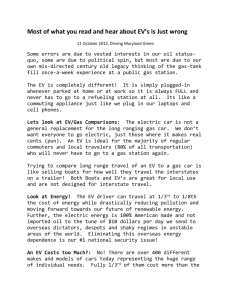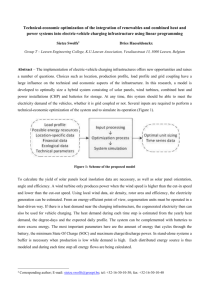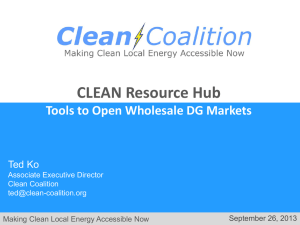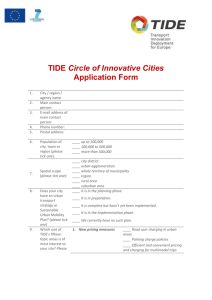CESA Energy Storage Roadmap Comments 2014-08
advertisement
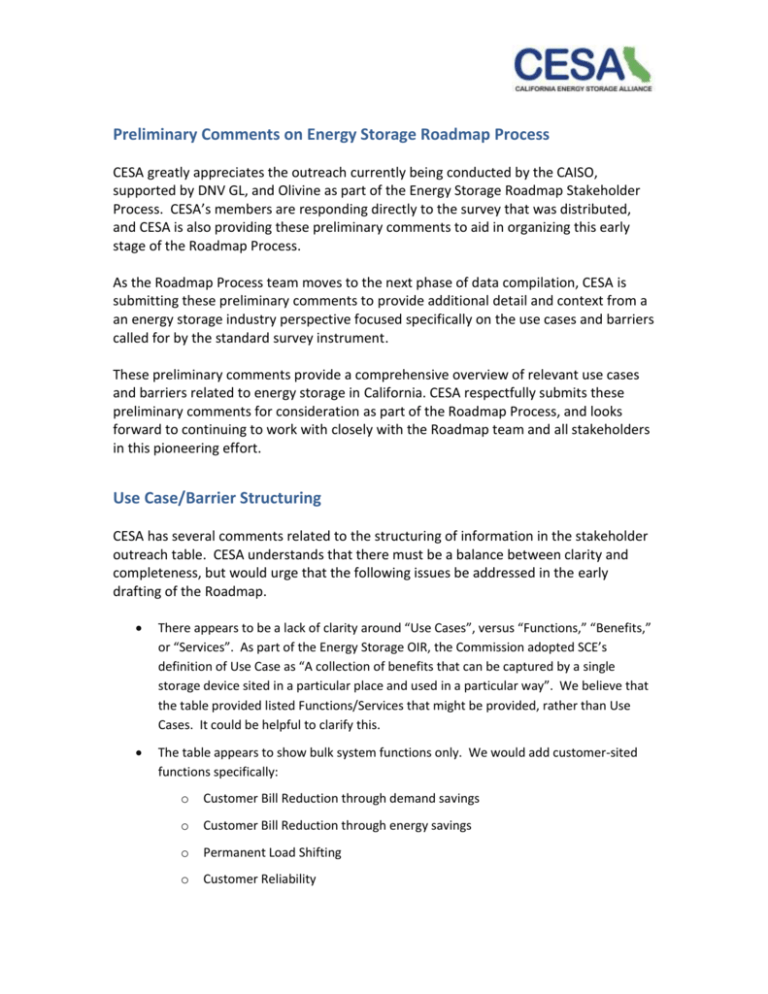
Preliminary Comments on Energy Storage Roadmap Process CESA greatly appreciates the outreach currently being conducted by the CAISO, supported by DNV GL, and Olivine as part of the Energy Storage Roadmap Stakeholder Process. CESA’s members are responding directly to the survey that was distributed, and CESA is also providing these preliminary comments to aid in organizing this early stage of the Roadmap Process. As the Roadmap Process team moves to the next phase of data compilation, CESA is submitting these preliminary comments to provide additional detail and context from a an energy storage industry perspective focused specifically on the use cases and barriers called for by the standard survey instrument. These preliminary comments provide a comprehensive overview of relevant use cases and barriers related to energy storage in California. CESA respectfully submits these preliminary comments for consideration as part of the Roadmap Process, and looks forward to continuing to work with closely with the Roadmap team and all stakeholders in this pioneering effort. Use Case/Barrier Structuring CESA has several comments related to the structuring of information in the stakeholder outreach table. CESA understands that there must be a balance between clarity and completeness, but would urge that the following issues be addressed in the early drafting of the Roadmap. There appears to be a lack of clarity around “Use Cases”, versus “Functions,” “Benefits,” or “Services”. As part of the Energy Storage OIR, the Commission adopted SCE’s definition of Use Case as “A collection of benefits that can be captured by a single storage device sited in a particular place and used in a particular way”. We believe that the table provided listed Functions/Services that might be provided, rather than Use Cases. It could be helpful to clarify this. The table appears to show bulk system functions only. We would add customer-sited functions specifically: o Customer Bill Reduction through demand savings o Customer Bill Reduction through energy savings o Permanent Load Shifting o Customer Reliability These functions often have very different barriers than the utility-side services listed, so differentiation now could be helpful. The table does not differentiate between connection locations (transmission connected, distribution connected, and customer sited) that could be critical to parsing out which and how barriers apply. The table does not differentiate by resource owners or dispatch parties. Barriers and rules will vary widely between systems that are rate based, IPP owned, 3rd party financed, and customer owned, so ownership and dispatch would be worth addressing at some point. The table addresses combinations of functions in only a limited way. In our experience, the combinations make for the greatest difficulty under our current rules. CESA’s Proposed Energy Storage Use Case List In an effort to provide a more complete list of use cases than currently provided in the table, CESA has compiled the following additional table. We believe this represents the most common use cases in California. Standalone Transmission Sited Generator Paired Standalone Distribution Sited Generator Paired Rate Based (Trans Deferral & NERC Reliability) Rate Based (Economic - Congestion Mgt, Avoiding lost cust. svc) Rate Based (Policy - Renewables Integration – operational integration (e.g., ramping) and RPS curtailment avoidance) Dual Use (Partial Rate Based, Partial Market Participant) Market Participant - Bulk Peaker (Energy, AS, & Resource Adequacy capacity) Market Participant - AS Only VER 1 (wind/solar) VER 2 (CSP molten salt) Thermal + Turbine Inlet Chilling or CAES Hybrid Thermal + Fast Response Storage Thermal + Oxygen Chilling Rate Based (Reliability - Dist Deferral, load mgt.) Rate Based (Policy - enabling more cost effective DG, EVs) Dual Use (Partial Rate Based, Partial Market Participant) Market Participant - Bulk Peaker (Energy & AS) Market Participant - AS Only Community Energy Storage Community Energy Storage + VER VER 1 (wind/solar) VER 2 (CSP molten salt) Demand Side PLS Bill Management & Demand Response Bill Management + Market Load-Paired / Participation BTM Utility Controlled Reliability EV Charging Thermal + Turbine Inlet Chilling or CAES Hybrid Thermal + Fast Response Storage Thermal + Oxygen Chilling Permanent Load Shifting - Electric Business Customer, Building Thermal Mgt. Business Customer, Peak/Max Demand Mgt. Business Customer, Peak/Max Demand Mgt. + Solar Residential Customer, TOU Bill Management Residential Customer, TOU Bill Management + Solar Aggregated C&I / VNM Solar + Storage Multi-family Residential, Solar and Demand Mgt. Business Customer, Bill + Market Participation Business Customer, Bill + Market Participation + Solar Residential Customer, Bill + Market Participation Residential Customer, Bill + Market Participation + Solar Grid Operation Benefits Storage to provide reliability and aggregated market services Storage to provide reliability and DR EV Charging, Public Charging Station EV Charging, Commercial or Municipal Fleet EV Charging, Residential Home Solar + Storage + EVs with bidirectional mkt participation Storage + EVs with bidirectional mkt participation EV Aggregated Charging with Market Participation (V1G) EV Aggregated Charging/Discharging with Market Participation (V2G) CESA’s Initial Energy Storage Barriers List FCESA has compiled a preliminary list of barriers that we see for energy storage. Many of these are being addressed in current policy proceedings, but for the sake of completeness, we are ilistinging them here. Barriers included in Energy Storage Roadmap Survey are italicized. 1. Interconnection Barriers 1.1. Energy storage charging for wholesale market functions should be at wholesale rates. Rule 21 and PTO load interconnection tariffs should be revised to clearly define what functions of an energy storage resource constitute “load” versus what is not considered end use load. Charging with the intent of storing power for resale should be excluded from the definition of load because it is not an end use of power. On the other hand, station power, such as heating and lighting, is an end use of power and such activities should be considered “load.” This is a critical issue for the energy storage industry due to the conflicting study processes and network upgrade cost allocation methodologies between generation and load interconnection tariffs. Such a move is also consistent with federal policy (FERC Order 792) and there is precedent with other states’ PUCs (Texas) setting such a policy. 1.2. Charging Tariff Design. Standalone or generation-paired resources should be excluded from the definition of end-use retail load, therefore removing any ambiguity with respect to the CAISO’s intent to allow such resources to be eligible for wholesale market participation for both charging and discharging. 1.2.1.Load-paired resources should have a dynamic pricing mechanism to enable aligning end use demand shaping (& demand response activities) with local and bulk system conditions, but should also be able to access wholesale market pricing for charging specifically associated with any direct wholesale grid services they are providing (i.e. not for the purpose of meeting end use load or for demand response programs). 1.2.2.Recommendation: The Commission should direct the utilities to develop new tariff structures for charging of distribution system-connected energy storage resources. 1.3. Implementation of D.14-05-033. The Commission should revise Rule 21 to make any necessary changes required to conform to the direction provided in D.14-05-033 to interconnection of energy storage paired with generation that is NEM-eligible, as well as generation paired with energy storage that does not operate under Schedule NEM. 1.4. Non-Exporting Interconnection Agreements. Rule 21 should be revised to exempt behind-the-meter energy storage resources that either only operate when the grid is down or will never export energy to the grid from signing interconnection agreements. 1.5. Non-Exporting Interconnection Fees. The $800 interconnection application fee for non-exporting energy storage should be cost-based at a considerably lower level and capped. 1.6. Output Capacity Measurement. Where there is a single point of interconnection for storage and generation, that point should be used to assess maximum output capacity of the paired system, rather than separately counting individual generator and storage capacities. 1.6.1.This issue, seeks to proactively address a potential future concern rather than having to raise these issues after the fact. Utilities assess costs associated with interconnecting storage and solar, which involves simply summing the inverter capacities of the solar and the storage system to assess the distribution capacity that is required to accommodate a project. However, in many cases, co-located storage with renewable generation will only be used for ramping or smoothing, so the storage output should not be added to the generator pMax. Implementation may require a technical/algorithmic limit on the total system output. 1.7. Disconnection Requirements. Rule 21 should be revised to rationalize and standardize disconnection requirements. 1.7.1.As an example, please see Attachment A for a configuration SCE is requiring of SolarCity in their service territory. Disconnect B isunnecessary because of the UL certified anti-islanding features of the solar inverter. Once disconnect A is tripped the solar inverter also trips off, rendering disconnect B unnecessary. 1.7.2.Figure A: Disconnect Requirements in SCE Territory 1.7.3.Disconnect B is, in CESA’s view, unnecessary because of the UL certified antiislanding features of the solar inverter. Once disconnect A is tripped the solar inverter also trips off, rendering disconnect B unnecessary. 1.8. Streamlining Rule 21/WDAT Transitions. The Commission should address streamlining the interface between Rule 21 and PTO queue management processes. An applicant should be able to transfer immediately from the Rule 21 distribution queue to the WDAT transmission queue if study results indicate that is appropriate, without having to wait for the next open window. Conversely, if study results indicate that it is appropriate for an applicant to transfer to the Rule 21 queue from the WDAT queue it should be able to do so immediately without waiting for the next acceptance window to open. 1.9. Technical Screen Requirements. 1.9.1.Screen I, Options 3 & 4 and Screen J –These screens should be revised to allow for larger systems without non-export relays in view of non-export relay costs and the fact that operation under Schedule NEM eliminates any economic incentive to export energy. 1.9.2.Screen B – This screen should be revised to make UL 1741 listing clearly sufficient to meet all requirements, and that UL 1741 listing of individual generators is sufficient, and It should also be clarified that a bank of generators does not need to be UL Listed as such whether or not a group is separately packaged or further enclosed within an additional chassis. 1.9.3.Screen I – This screen non-­­export path Option 3 should be revised to Increase the rating threshold to 50% rather than the current 25% of the service equipment. 1.9.3.1. The goal of this change is to harmonize the percentage of service equipment rating with the percentage of service transformer capacity rating. It is unclear why there is a more restrictive threshold on the percentage the percentage of service equipment (25%) vs percentage of service transformer capacity rating (50%). 1.9.3.2. In the case of a 100 amp rated service equipment, a 25% limit would be 25 amps, which is equivalent to 6,000 watts at 240 VAC (25A x 240V = 6,000W). In cases where the customer is planning to use a battery inverter to supply the entire house load at times, a 6,000 W inverter may be too small. 1.9.4.Screen M – The 15% peak load limit of his screen should be raised for all generation, whether or not it is paired with energy storage. 1.10. Worst Case Study Assumptions & Upgrade Requirements. Energy storage resource interconnections can be cost prohibitive when they are studied assuming worst case charging/discharging. Studying worst case may actually run counter to the point of installing energy storage devices, which are in many cases being built to mitigate worst case impacts that are very unlikely to occur. For example, multi-hour resources are unlikely to be charging when system loads and market prices are high. Appropriate assumptions should be used to study the impacts of energy storage in the interconnection process, and the proper dispatch and reliability software should be used to manage impacts, rather than installing expensive new network upgrades to manage worst case impacts. 1.11. Cluster study opt-in for new tariff rules. Cluster 7 participants should have the right to opt in to new study rules under development at the CAISO. 1.12. Flexible deliverability interconnection study option. It would be helpful to create a “flexible deliverability” study to assess ability to provide system flexible RA in partial peak cases. 1.13. Safe Harbor for Eenergy Storage Material Modification Approval when PMax not changing. Adding storage to existing interconnection requests should not be deemed material so long as the PMax does not change. 1.14. Complex interconnection rules inhibiting adoption* 1.15. Cost to meet interconnection rules inhibiting adoption* 1.16. Cost and complexity of the WDAT specifically* 2. RA/Capacity 2.1. Deliverability Status is needed for resources providing only flexible capacity or flexible capacity greater than standard capacity. 2.2. EFC should be unbundled from NQC. 2.3. The value of RA is uncertain in a variety of situations. 2.4. Deliverability calculations for Distributed/Aggregated resources are unclear. 3. Demand Response 3.1. Reduce Proxy Demand Response (“PDR”) participation size requirements. Reform existing 100kW proxy demand resource minimum requirements to improve participation. Bring the minimum requirement to 5kW (or as low as possible) to allow many behind the meter resources, including those facilitated by energy storage, to compete in the market. 3.2. Reduce Participation Duration Requirements. 3.3. Allow the Use of Least Cost Metering Solutions. 3.4. Allow DR to Compete with Generation in Wholesale Electricity Markets. Remove DR participation barriers for energy, day-ahead scheduling reserve, capacity, synchronized reserve and regulation. 3.5. Create Additional Dispatch Windows for Load Modifying and Supply Resource Demand Response. Many IOU administered DR programs have a 1PM-7PM dispatch window, which doesn't allow energy storage to plan for peak shaving. 3.6. Create Year Round DR Market Products. 3.7. Allow Supply Resource Demand Response to Capture Resource Adequacy Value. DR resources need to be able to capture full RA value, including flexible capacity. 3.8. Continue to Provide Clarity in Updating Sub-LAPs and Assigning them to Pricing Nodes. 3.9. Remove Barriers for EV Participation in DR. Stationary energy storage coupled with EV charging infrastructure cannot simultaneously participate in traditional utility DR programs and provide services to the CAISO because DR participants are typically prohibited by utility tariffs from participating in multiple DR programs at the same time. 3.10. Properly Value Highly Dispatchable DR Resources. Establishing a value matrix for slow, fast, short, and long duration resources to provide clarity for the marketplace. 3.11. Test market participation with charge and discharge capable energy storage systems, capable of absorbing “excess supply” in different scenarios. 4. Metering & Telemetry 4.1. Increased expense of duplicative metering 4.2. Cost and complexity of required telemetry 4.3. Inability to track where/how storage is being charged preventing enabling tariffs from being applied 4.4. Undetermined telemetry requirements for behind-the-meter frequency regulation 5. Behind the Meter (BTM) Wholesale Participation 5.1. A reconciliation method is needed for Retail/Wholesale uses 5.2. There is a lack of clarity around the BTM wholesale compatibility with retail programs (eg NEM, etc.) 5.3. Supply/Demand Side DR program rules are not finalized for energy storage. 6. Ancillary Services 6.1. Lack of ability to access products from behind-the-meter points of connection 6.2. No enablers that allow operators to leverage unique characteristics of storage (Regulation, Black Start, Spinning Reserve) 6.3. Not all benefits of storage can be monetized due to lack of product availability 7. Ratemaking Issues 7.1. Clarifying Wholesale Market Applicability for Charging (correlated with issues 1.1, 5.1, 5.2) 7.2. Retail Rate Design for Grid Responsive Resources 7.3. Retail Rate Incentives for Smart Charging & Discharging 7.4. Retail/TOU/Dynamic rates should reflect net peak 8. Standards 8.1. Lack of vetted standards in areas such as safety and reliability preventing storage from being easily installed and deployed. 8.2. Lack of local codes / approval listings creating difficulty and time in commissioning projects 9. Financial 9.1. Lack of long-term contracts for energy storage make financing projects difficult. 9.2. Lack of access to all revenue opportunities for storage preventing financing packages being established for storage 9.3. Lack of electricity tariffs that allow all storage benefits to be monetized. 10. Market and Regulatory 10.1. Under NGR Rules, energy storage resources cannot bit into multiple segments. For instance, this prevents a storage resource from putting in a higher bid for a deep discharge versus a shallow discharge. 10.2. ISO treatment of storage assets as conventional generation in regards to ancillary service certification quantities and maximum generation 10.3. One LSE per PDR (and presumably per NGR due to procurement issues) prevents widespread deployment 10.4. class Storage is not defined as an asset, either generation or transmission or unique 10.5. Minimum size requirements to participate in market opportunities 11. Modeling 11.1. No standard cost-effectiveness modelling tool available to the industry 11.2. Hybrid applications of storage not accurately being modeled or benefits not being fully accounted for 11.3. Some storage technologies not accurately being modeled by ISO


